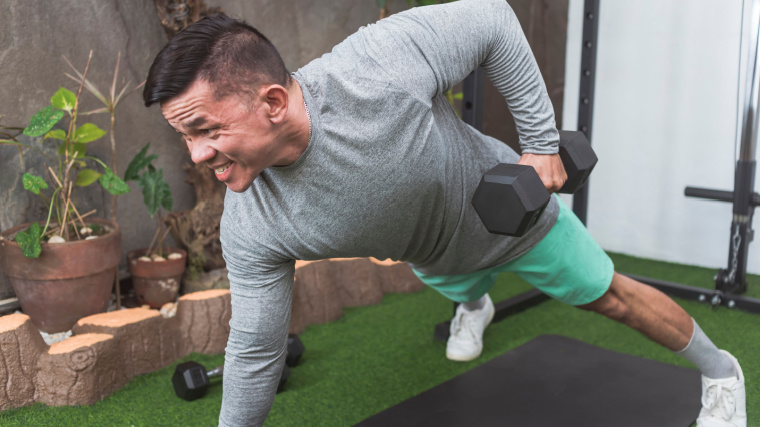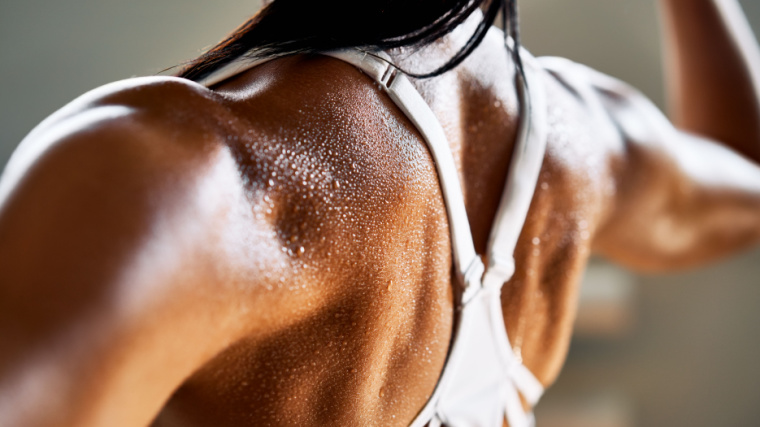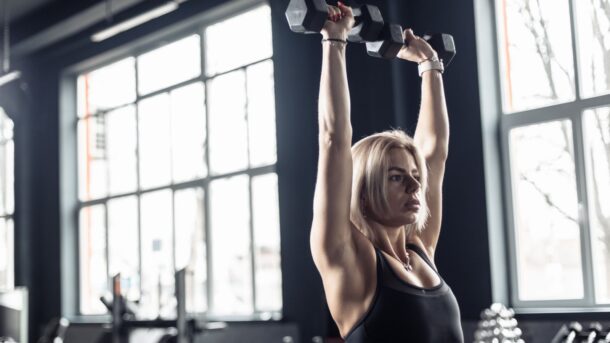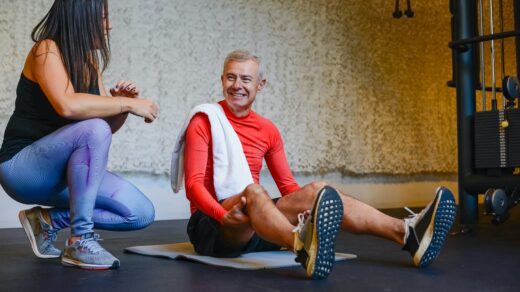Many people want to show up to the gym, exercise just enough to achieve their results, and get out ASAP to return to “the real world.” Sure, there are some who use the gym as a meditative space and nearly reach a Zen state after a few dozen sets of moving iron, but that’s not the majority.
Fast and efficient training is essential for getting results with relatively short workouts, and HIIT workouts are one effective way to get there. High intensity interval training, or HIIT, is a training technique that repeats alternating periods of challenging exercise with periods of recovery throughout a training session.

HIIT can be applied to any number of workout methods, from barbell training to treadmill workouts. To crank up the efficiency to the maximum, here is a detailed routine to train your entire body with a single HIIT workout.
Full-Body HIIT Workout
The Total Body Dumbbell HIIT Workout
This total-body workout requires a pair of dumbbells at an appropriate weight and some clear floor space. That’s it. With this minimal setup, you can perform the workout at home, outdoors, in a crowded commercial gym, at the most barebones hotel gym when traveling, or anywhere you need a quick and effective workout.
Because you’re training your entire body, perform the workout one to three times per week depending on your overall training plan. You can program the workout as a cardiovascular conditioning session or, if you pair it with a well-designed nutrition plan, it can fit right into a fat loss routine.
HIIT workouts are typically defined by intense training phases interspersed with periods of rest. This workout satisfies that approach by working your upper and lower body with supersets (the intense phase) and capping off the paired exercises with a loaded carry (the “recovery”). Repeat the first three-exercise series for three to four total sets before moving to the second three-exercise series.
If needed, rest up to three minutes between each series, but aim to complete the full workout without significant rest.
Dumbbell Deadlift
The deadlift is a high-impact, bang for your buck exercise. Switching from a barbell to dumbbells trades maximum weight for slightly more muscle recruitment and longer range of motion, which can yield better overall results from a conditioning and muscle-building perspective.
The weights will likely not challenge your grip strength significantly, so focus on strict form throughout the set. Don’t allow the circuit format to trick you into rushing through a partial range of motion.
- How to Do it: Stand upright holding a pair of dumbbells at your side. Take a hip-width stance and slightly bend your legs. Maintain a neutral spine and shift your hips back. Lower the weights toward your toes by bending your legs and driving your hips and glutes toward the wall behind you. When you feel a maximum stretch in your hamstrings, push your hips forward until you return upright.
- Sets and Reps: 3-4 x 10-12
- Rest Time: No rest before moving to the next exercise
Benefits of the Dumbbell Deadlift
- The dumbbell deadlift primarily works your glutes and hamstrings with assistance from your upper and lower back.
- The exercise allows a relatively longer range of motion compared to a barbell deadlift, which can increase overall muscle activation.
Hammer Curl and Press
This is a dumbbell variation of a clean and press, which works the majority of muscles in your upper body. The standard clean and press uses explosive lower body movement to initiate the exercise, but the hammer curl and press maintains focus on your upper body — specifically your shoulders, upper back, and arms.
The thumbs-up, hammer curl position puts your arms in a mechanically strong pulling position (compared to a traditional palm-up curl) while also recruiting your brachialis for increased overall arm size.
- How to Do it: Stand up holding a pair of dumbbells at your sides. Keep your core tight and don’t use your torso to swing the weights up. Perform a powerful hammer curl, keeping your elbows pinned to your sides while driving your thumbs toward your shoulders. As the weights approach the top position, smoothly transition into an overhead press. After locking the weights overhead, reverse the entire process to bring the weights down to your sides.
- Sets and Reps: 3-4 x 10-12
- Rest Time: No rest before moving to the next exercise
Benefits of the Hammer Curl and Press
- The hammer curl and press efficiently trains your biceps, shoulders, triceps, upper back, and core in a single movement.
- The movement can be performed with strict form for maximum upper body muscle activation. Lower body involvement (“leg drive”) can be added as a deliberate technique to increase training volume after fatigue begins to set in, similar to performing forced reps.
Rack Walk
The rack walk is a farmer’s carry variation that supports the weight with your arms bent and the weight at shoulder-level. This shifts your center of gravity, making the exercise much more demanding on your core than your grip.
Unlike a traditional farmer’s walk with your arms by your side, your grip strength is nearly a non-issue with the exercise because your hands and forearms aren’t supporting the weight. Your upper back, shoulders, abdominals, and lower back are the primary stabilizers.
- How to Do it: After the final repetition of the hammer curl and press, lower the weight to shoulder-height but don’t “curl” the weight down to your sides. Keep your palms facing in toward each other and let the thumb-side of the dumbbell rest on the front of your shoulder — not the top of your shoulder near your neck. Keep your elbows aimed forward or slightly up and walk with cautious, deliberate steps. Keep your core tight and your shoulder blades pinched together. When the set is completed, carefully bring the dumbbells to the floor and rest.
- Sets and Reps: 3-4 x 100 total steps or roughly one minute
- Rest Time: Rest 60 seconds before repeating the first exercise.
Benefits of the Rack Walk
- This loaded carry variation emphasizes core strength and stability, while many other loaded carries can be limited by your grip strength.
- The rack walk, and other loaded carries, allows lifters to perform high-intensity cardiovascular exercise while moving at a relatively lower speed (without running). This can benefit those with pre-existing knee or ankle problems and those with general mobility issues.
Reverse Lunge
The reverse lunge is a unilateral (single-leg) exercise which helps to address the kinds of strength and muscular discrepancies that naturally occur in most people. Many lifters overfocus on bilateral (two-leg) movements, but the simple addition of a lunge can significantly improve overall results.
By stepping backward, your front leg — the one doing the majority of the work — is kept in a relatively stable position. This helps to decrease knee strain, making the exercise an ideal choice for anyone with lower body aches and pains.
- How to Do it: Stand up straight with the dumbbells down at your sides. Take a longer-than-usual step backward with your right leg, landing on the ball of your foot. Keep your torso mostly vertical as you step. Bend your left leg to descend, keeping the majority of your body weight distributed on your left foot. When you reach a comfortable depth, possibly with your right knee grazing the floor, drive through your left foot and bring your right leg forward to the starting position. Repeat with the opposite leg. One step with each leg is considered “one rep.”
- Sets and Reps: 3-4 x 10-12 reps per leg
- Rest Time: No rest before moving to the next exercise
Benefits of the Reverse Lunge
- Unilateral leg exercises like the reverse lunge may carryover to improved strength, stability, and athleticism. (1)
- The reverse lunge can help to address potential strength discrepancies, which may help to reduce the risk of injury.
Renegade Row
The renegade row just might be one of the most efficient ways to build high-level strength in your entire upper body. It combines the dynamic core-stability benefits of a plank with the back and shoulder muscle-building benefits of a dumbbell row, using no equipment beyond some simple dumbbells.
This exercise can even be performed without any weights. You’ll lose almost all of the back and shoulder-building benefits, but you’ll still have an intense plank variation to work your abs, obliques, lower back, and hips. A more advanced variation adds a push-up after each dumbbell row.
- How to Do it: Assume a push-up position on the floor holding a dumbbell in each hand with your palms facing each other. Drive through your arms to press the weights into the ground for added stability. Support yourself on your toes with your legs straight. Maintain a neutral spine, not allowing your hips to dip toward the ground or pitch up to the ceiling. Drive your left elbow up, pulling the weight toward the outside of your ribs. Pause briefly before lowering the weight. Re-stabilize your body before repeating with the opposite side.
- Sets and Reps: 3-4 x 10-12 reps per arm
- Rest Time: No rest before moving to the next exercise
Benefits of the Renegade Row
- The renegade row builds core strength and stability, similar to an advanced plank.
- The exercise builds “functional” total-body strength by actively pulling with one side of the body while coordinating stability with the opposing side.
Suitcase Carry
The suitcase carry is essentially a one-arm farmer’s walk. It yields the head-to-toe strength and conditioning benefits of the classic farmer’s walk while overloading your core stabilizers by offsetting the load to one side of your body.
When performing the suitcase carry, aim to walk with a relatively smooth stride. Try not to let the weight lurch you off-course with each step. Control the weight and maintain your posture for maximum benefit.
- How to Do it: Stand with a dumbbell in one hand, at your side. Keep your arm straight and your shoulders pulled back. Maintain a vertical torso — don’t allow the weight to pull you to one side and don’t overcompensate by leaning excessively away from the weight. Walk with steady, deliberate steps. After you’ve reached the predetermined distance, switch hands and repeat. The set isn’t considered complete until you’ve walked with the weight on both sides.
- Sets and Reps: 3-4 x 50 steps (or roughly 30 seconds) per arm
- Rest Time: Rest 60 seconds before repeating the first exercise.
Benefits of the Suitcase Carry
- Holding a dumbbell in only one hand creates an offset load which increases recruitment of core stabilizers, specifically your oblique muscles and lower back.
- The suitcase carry will build grip strength as a secondary benefit to core stability and cardiovascular conditioning.
Muscles Trained During a Full-Body HIIT Workout
While this is technically a full-body HIIT workout, and your entire body is being stimulated throughout the session, some body parts are more directly recruited than others.
Back
The muscles across your entire back — including your lower back, upper back, and lats — will be recruited during the majority of exercises in the workout. Your back muscles will either be involved actively (for example, during the hammer curl and press and the renegade row) or as stabilizers (during the dumbbell deadlift and loaded carries)
Shoulders
Your shoulder muscles are heavily involved to stabilize the weight during any loaded carry. They are also directly recruited during the hammer curl and press and renegade row. Due to their relative size and strength, your shoulders may fatigue before other body parts during the workout.
Adjust the weight (and, if necessary, the sets and reps) to accommodate the weakest link. As your body progressively adapts to the strain, your shoulder strength should significantly improve.

Legs
Your hips, glutes, quadriceps, hamstrings, and calves will receive ample stimulation from the majority of exercises in the workout. The dumbbell deadlift emphasizes your glutes and hamstrings, while the reverse lunge is a very effective quadriceps exercise.
Both the rack walk and suitcase carry will work your hips and calves, as those muscle groups are highly active during unweighted walking. Performing any loaded carry increases the recruitment of these critical muscles even moreso. The suitcase carry, interestingly, may also increase recruitment of the glutes to provide stability while walking. (2)
Core
Your core, generally considered to include your abdominals and lower back, gets a serious workout during any loaded carry. Because the renegade row could be considered a dynamic variation of the plank (which is a fundamental core-training exercise), it also directly works your core.
A dedicated ab exercise isn’t included in this full-body HIIT workout because it could potentially cause excessive fatigue and interrupt performance of the primary exercises. A separate ab workout could be performed on a day when you’re not also performing this HIIT workout.
How to Warm-up for a Full-Body HIIT Workout
A thorough, if brief, warm-up can improve performance in a weight training session. (3) These benefits are essential even when the session is conditioning-focused, rather than a training plan designed for strength or muscle-building. Here’s an efficient way to prepare yourself for this full-body HIIT workout without high levels of fatigue.
Run through the following series as a circuit, performing the exercises in sequence, before resting briefly. Repeat for a total of three circuits. This efficient warm-up is done using only your body weight.
- Squat: Take a slightly wider than shoulder-width stance. Squat as deep as mobility allows — as you progress through the warm-up, your depth will likely increase. Focus on keeping your feet flat on the floor and your torso vertical. Perform 10 to 15 repetitions.
- Single-Leg Toe Touch: Take a staggered stance with one foot slightly in front, and to the side of, the other. Hinge at your hips and reach toward your front foot while keeping a neutral spine. If your balance allows, let your rear leg slightly elevate into the air. When you feel tension in the back of your front leg, return to a standing position. Perform 5 repetitions per leg.
- Push-up: Drop into a classic push-up position, supporting your body on your hands and toes while keeping a straight line through your trunk and legs. Set your hands slightly wider than shoulder-width apart. Bend your arms to lower yourself as close to the ground as comfortable. Pause briefly before returning to the top position. Perform 5 repetitions.
- Shoulder-Tap Plank: After your final push-up, hold the top position. Spread your feet well-beyond shoulder-width. Brace your right arm securely by driving your right hand into the ground. Quickly “tap” your right shoulder using your left hand before returning to the full push-up position. Repeat with the opposite side. Continue alternating taps for 5 repetitions per side.
Head-to-Toe HIIT
HIIT workouts don’t need to include high-repetition bodyweight exercises or high-athleticism explosive plyometrics. A HIIT session only needs you to push yourself hard before recovering enough to go just as hard in the next set. This blend of full-body supersets and loaded carries fits the bill. If and when you discover an appreciation for HIIT, don’t be surprised if these efficient sessions make recurring appearances in your regular programming.
References
- Speirs, Derrick E.1,2; Bennett, Mark A.3; Finn, Charlotte V.4; Turner, Anthony P.2. Unilateral vs. Bilateral Squat Training for Strength, Sprints, and Agility in Academy Rugby Players. Journal of Strength and Conditioning Research 30(2):p 386-392, February 2016. | DOI: 10.1519/JSC.0000000000001096
- Holmstrup, M. E., Kelley, M. A., Calhoun, K. R., & Kiess, C. L. (2018). Fat-Free Mass and the Balance Error Scoring System Predict an Appropriate Maximal Load in the Unilateral Farmer’s Walk. Sports (Basel, Switzerland), 6(4), 166. https://doi.org/10.3390/sports6040166
- Fradkin, Andrea J1; Zazryn, Tsharni R2; Smoliga, James M3. Effects of Warming-up on Physical Performance: A Systematic Review With Meta-analysis. Journal of Strength and Conditioning Research 24(1):p 140-148, January 2010. | DOI: 10.1519/JSC.0b013e3181c643a0
Featured Image: Vladimir Sukhachev / Shutterstock







